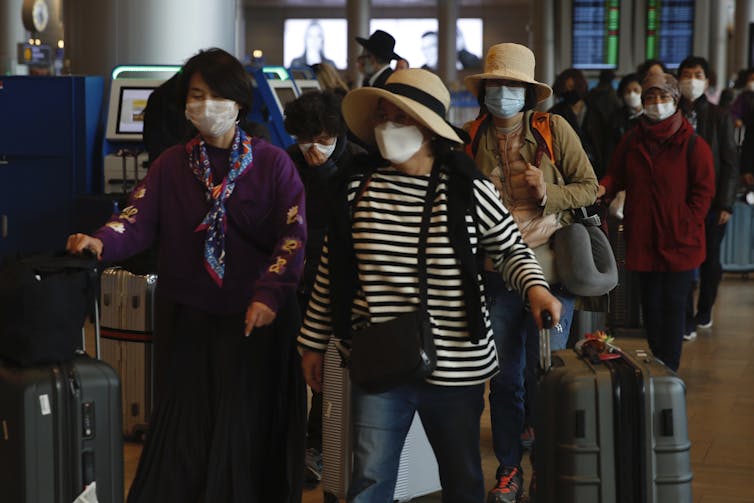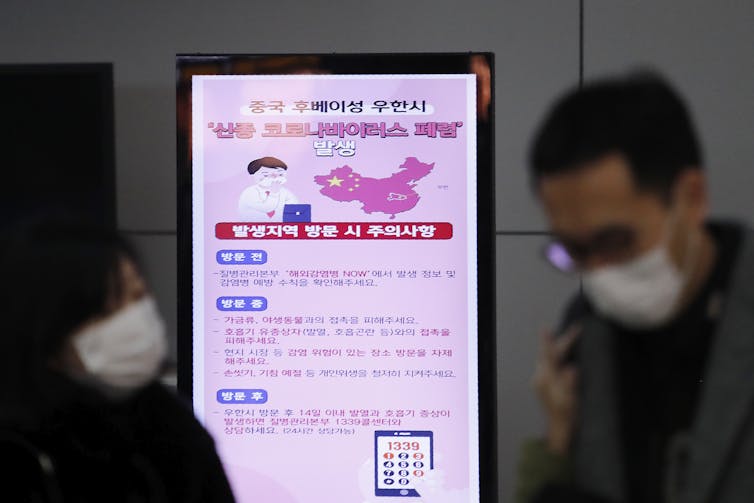Airplanes spread diseases quickly – so maybe unvaccinated people shouldn't be allowed to fly
- Written by Christopher Robertson, Professor of Law, University of Arizona
As the coronavirus spreads, the nation’s leading health official told a Senate committee on Feb. 25 that “we cannot hermetically seal off the United States to a virus[1].”
The comments from Alex Azar II, head of Health and Human Services, heightened concerns about the effects of the coronavirus in the U.S., which so far has sickened a relatively small number – 57 – of people in the U.S.
And with hundreds of new cases of the coronavirus reported in South Korea[2], a spike of deaths in Iran[3], and a 10-town lockdown in Italy[4], the rapidly spreading COVID-19 may be on the verge of becoming a pandemic[5]. The World Health Organization now says the disease has “pandemic potential[6].”
This is only the latest outbreak to show how quickly pathogens can spread in a changing world. The worldwide response[7] is a testament to the immediate need for intervention and containment: flights canceled, cruise ships quarantined, travel banned, and a rigorous monitoring of the Chinese response.
What is now beyond dispute is that airplanes are giving the virus a big boost. As legal and public health scholars, we study[8] how airline travel[9] contributes to the spread of infectious agents, and how potential vaccines could limit it.
The global impact of flights
The 2002 SARS epidemic[10] cost airlines an estimated US$7 billion. After factoring in suspended flights, the impingement on trade, and the transport of Chinese-made medical supplies[11], the cost of COVID-19 will likely be much larger.
This is nothing new. Air travel is a way to spread many virulent infectious diseases, including[12] diptheria, hepatitis A, influenza A and B, measles, mumps, meningococcus, rubella, tuberculosis, norovirus – the list goes on. In the U.S., airlines move[13] more than two-and-a-half million people per day, squeezing them into long metal cylinders where all share the same air, the same restrooms, and take meals shoulder-to-shoulder for hours and hours.
Measles outbreaks[14] have begun at airports. One plane[15] carrying a single symptomatic SARS patient saw the disease develop in at least 16 others. Transmission of seasonal influenza during flights is well documented; after 9-11, when U.S. airline travel stopped abruptly, the pattern of mortality associated with it or pneumonia dramatically shifted[16]. Consistently, the research finds the single most significant predictor of influenza spread is domestic airline volume.
There is no doubt that close contact[17], especially when prolonged, spreads contagion. This is true for respiratory droplets, direct skin contact, and sometimes, fecal or oral spread. Making matters much worse: Airlines, taking people from place to place, turn what might otherwise be local outbreaks into worldwide crises.
It’s hard to conceive a more efficient way to spread infectious disease.
 Tourists wearing protective masks from Korea walk through Ben Gurion Airport near Tel Aviv, Israel.
AP Photo / Ariel Schalit[18]
Tourists wearing protective masks from Korea walk through Ben Gurion Airport near Tel Aviv, Israel.
AP Photo / Ariel Schalit[18]
What are potential solutions?
The CDC maintains a “do-not-board” list[19] prohibiting people with a communicable disease from flying. Yet these policies only work for patients already diagnosed, or with overt symptoms, and viral disease transmission typically begins days, even weeks, before symptoms appear. For example, the incubation period[20] for COVID-19 is believed to be between two days and two weeks; for many people, fever is the first and only sign of infection. In these situations, our current policies don’t work.
One suggestion: Airlines could require vaccination for passengers[21], or at least make them show a medical exemption as to why they cannot be vaccinated. Perhaps now is the time to consider this. Right now, scientists are urgently working to develop a COVID-19 vaccine. If they succeed, a vaccine dissemination strategy will be needed immediately. Also, just this month, the FDA approved[22] a new vaccine for pandemic influenza (H5N1). As for the seasonal flu vaccines, they are already here.
All this provides an excellent test bed for finding a way to vaccinate the broad population during a pandemic. Vaccines could be available at airports (as some are now doing[23] for existing vaccines). But we believe a longer-term term goal is to create a database to identify who has been vaccinated, for future seasonal flu episodes and epidemics. This supports the public health approach to deal with future pandemics, when new vaccines are quickly developed.
 At Incheon International Airport in South Korea, a poster warns about coronavirus as passengers wear masks in a departure lobby.
AP Photo / Ahn Young-joon[24]
At Incheon International Airport in South Korea, a poster warns about coronavirus as passengers wear masks in a departure lobby.
AP Photo / Ahn Young-joon[24]
Legal and ethical considerations
Clear legal authority[25] exists to link a vaccination mandate to air travel. After 9-11, the courts emphasized[26] that airlines are duty-bound to protect their passengers and those on the ground from risks. The CDC or Surgeon General could exercise authority[27] to “make and enforce such regulations … to prevent the spread of communicable diseases.” Under the U.S. Constitution, the federal government indisputably has the power to act when regulating “channels of interstate commerce.” That includes the airlines.
What about the rights of individuals who refuse to vaccinate? Courts have long upheld vaccination mandates for schools, where close and prolonged contact is inevitable. Even though there is a “right to travel,” and there are laws protecting religious practices from government encroachment, our courts have explicitly declared vaccination is a government interest[28]; they’ve upheld vaccine mandates for more than a century.
These basic legal principles, along with the facts, suggest that airlines and airports are key to stopping the spread of disease. Public health interventions should obviously focus on them. After all, it’s where the impact is likely to be greatest.
[Expertise in your inbox. Sign up for The Conversation’s newsletter and get a digest of academic takes on today’s news, every day.[29]]
References
- ^ we cannot hermetically seal off the United States to a virus (www.nytimes.com)
- ^ South Korea (www.washingtonpost.com)
- ^ spike of deaths in Iran (www.nytimes.com)
- ^ 10-town lockdown in Italy (www.nbcnews.com)
- ^ becoming a pandemic (www.nytimes.com)
- ^ pandemic potential (www.washingtonpost.com)
- ^ worldwide response (www.who.int)
- ^ we study (scholar.google.com)
- ^ how airline travel (publichealth.arizona.edu)
- ^ 2002 SARS epidemic (www.reuters.com)
- ^ Chinese-made medical supplies (www.washingtonpost.com)
- ^ including (doi.org)
- ^ airlines move (www.faa.gov)
- ^ Measles outbreaks (doi.org)
- ^ One plane (doi.org)
- ^ dramatically shifted (doi.org)
- ^ close contact (doi.org)
- ^ AP Photo / Ariel Schalit (www.apimages.com)
- ^ list (www.cdc.gov)
- ^ incubation period (www.cdc.gov)
- ^ vaccination for passengers (papers.ssrn.com)
- ^ FDA approved (www.phe.gov)
- ^ are now doing (www.flysfo.com)
- ^ AP Photo / Ahn Young-joon (www.apimages.com)
- ^ Clear legal authority (papers.ssrn.com)
- ^ the courts emphasized (law.justia.com)
- ^ could exercise authority (www.law.cornell.edu)
- ^ government interest (www.oyez.org)
- ^ Expertise in your inbox. Sign up for The Conversation’s newsletter and get a digest of academic takes on today’s news, every day. (theconversation.com)
Authors: Christopher Robertson, Professor of Law, University of Arizona

